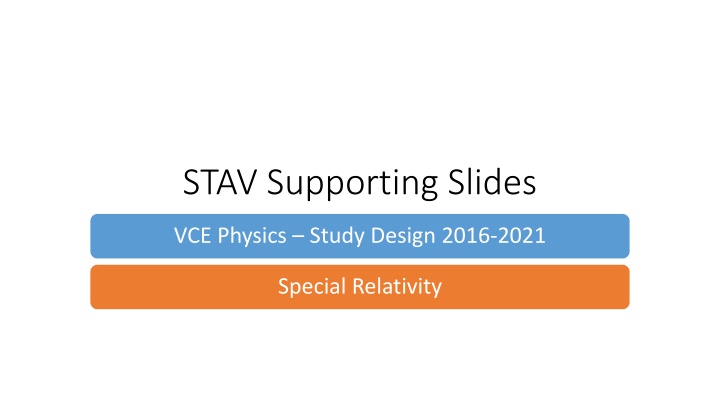STAV Supporting Slides
Explore the fascinating concept of time dilation in the realm of special relativity through visual representations and thought-provoking scenarios. Delve into how time intervals are perceived differently from different frames of reference, unraveling the complexities of time perception in motion.
Download Presentation

Please find below an Image/Link to download the presentation.
The content on the website is provided AS IS for your information and personal use only. It may not be sold, licensed, or shared on other websites without obtaining consent from the author.If you encounter any issues during the download, it is possible that the publisher has removed the file from their server.
You are allowed to download the files provided on this website for personal or commercial use, subject to the condition that they are used lawfully. All files are the property of their respective owners.
The content on the website is provided AS IS for your information and personal use only. It may not be sold, licensed, or shared on other websites without obtaining consent from the author.
E N D
Presentation Transcript
STAV Supporting Slides VCE Physics Study Design 2016-2021 Special Relativity
World-Map : from reference frame of platform All orange clocks showing same time synchronised
World-Map : from reference frame of platform One clock is proper time t0 Two clocks (more clocks) measure larger time interval. This is what was MEASURED t t > t0 Time interval measured from platform frame is longer This is Time Dilation
World-Picture : what is seen by the girl This is what I saw !
World-Picture : what is seen by the girl This is what girl SAW t0 > t t0 So, time on train is faster ! Approaching clocks LOOK like they are FAST. This is what I saw ! t Similarly - receding clocks LOOK like they are SLOW. Time dilation equation does NOT tell us what time will LOOK like.
The time dilation equation relates to measurements NOT what we see .
Motion is relative Motion is relative shouldn t time dilation be symmetrical? Experimenters in platform-frame measure time dilation of train-frame Train-frame should be able to measure time dilation of platform-frame how? Let s take a look
World-Map : from reference frame of train All blue clocks showing same time synchronised
World-Map : from reference frame of train t One clock is proper time (this time on platform) Two clocks (this time on train) more clocks = larger interval This is what was MEASURED t > t0 t0 Time interval measured from train frame is longer Time dilation again!... but this time other way around
Time Dilation (definition) proper time interval (single clock) measured as larger (dilated) from a relatively moving frame of reference (by two clocks).
People do NOT feel any different they do not experience time moving faster or slower.
? = ?0? dilated time interval two clocks larger proper time interval one clock smaller ?0=? ?
Key Skill Identifying which time interval is the proper time / shorter time, so that we know whether to multiple or divide by gamma.
Summary Time dilation = increase (dilation) of the measurement of a time interval. what we measure, NOT what we see. is a symmetrical effect BUT any particular measurement is not symmetrical. Single clock measurement = proper time less clocks = smaller time interval Two clock measurement (a relatively moving frame) = dilated time more clocks = larger time interval Time will seem to move faster (approaching) or slower (receding) mainly due to finite speed of light (+/- smaller SR effects). What time looks like is NOT covered by Study Design should be no exam questions on this.
Muons application of time dilation Lets look at exam question from sample exam:
fraction Expected answer = 22 s Actual answer = 2.2 s Nice 1960 s YouTube video: www.youtube.com/watch?v=tbsdrHlLfVQ determined by the scientists.
Muons alternative to sample question Students get given the half-life determined by the scientists measuring numbers at top and bottom of mountain and have to provide the proper half-life of the muon. Would then divideby gamma i.e. 22 s /10 = 2.2 s
Length Contraction How to park a stretched limo in a short garage!
How do you measure the length of an object? Use a ruler / tape measure Proper length, L0 = length measured in frame of rest of object
World Map v =?0 ? ?
World Map : train frame v ? =? ?
Key Skill Identifying which time interval is the proper length / longer length, so that we know whether to multiple or divide by gamma.
Summary Proper length = length measured by observer at rest relative to object Length contraction = decrease (contraction) of the measurement of a length. what we measure, NOT what we see. is a symmetrical effect BUT any particular measurement is not symmetrical. Length of object will appear to be longer (approaching) or shorter (receding) mainly due to finite speed of light (+/- smaller SR effects). Object is also distorted, colour is changed etc. What objects look like is NOT covered by Study Design should be no exam questions on this.
Twin Paradox If time permits ;-)
If time dilation is all about measurements is Time Dilation real ?
Is it real? Is it real? Real impacts e.g. GPS Thought Experiment Twin Paradox
Clocks and trains one-clock on train X X A B clock at either end of platform Y Y one-clock on another train total X + Y time is less than same interval measured on platform
Space ships and planets one-clock on spaceship X X clock on each planet A B Y Y one-clock on another spaceship total X + Y time is less than same interval measured by planets
Re-using the same clock one-clock on spaceship X X clock on each planet A B X X same spaceship total X time is less than same interval measured by planets
Twins One twin on spaceship X X One twin on planet A A B X X Twin returns Twin on spaceship is younger on return!
Objection / Paradox Objection / Paradox Motion is relative: Look at it from reference frame of Twin on spaceship Twin on planet ages less!
Twins One twin on spaceship X One twin on planet A A Twin on planet is younger on return?
Resolution Resolution Situation is not symmetrical Cannot construct one-clock / two clock in same way Twin on spaceship changes reference frame (accelerates at turnaround)
CAREFUL CAREFUL Acceleration is NOT central : if the spaceship just accelerated out and back without the long journey there would not be much ageing ageing is approximately just the one-clock two-clock ageing calculate difference in age with time-dilation equation (+/- insignificant bits ) Twin paradox resolved as situation is NOT symmetrical One twin remains in same frame of reference Other twin changes frame of reference OK so this requires an acceleration but can be minimised and is not the cause of the ageing (though cause depends on interpretation)
Clearing up misconceptions Clearing up misconceptions SR CAN deal with accelerations and CAN deal with Twin Paradox Even the +/- little bit calculus GR is NOT required to resolve Twin Paradox GR is NOT SR + acceleration GR = SR + Gravity Nice discussion (Scientific American): How does relativity theory resolve the Twin Paradox? Good detailed / technical discussion: Physics FAQ (Baez) Twin Paradox
Actual Twin Experiment Actual Twin Experiment Hafele-Keating Atomic clocks sent around the world on airliners Does require GR correction, gravitational field low vs high altitude.























